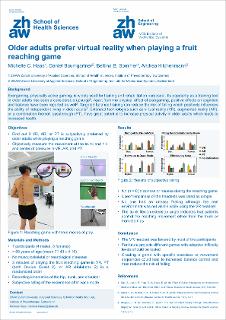Please use this identifier to cite or link to this item:
https://doi.org/10.21256/zhaw-29404| Publication type: | Conference poster |
| Type of review: | Peer review (abstract) |
| Title: | Older adults prefer virtual reality when playing a fruit reaching game |
| Authors: | Haas, Michelle C. Baumgartner, Daniel Sommer, Bettina Kilchenmann, Andrea |
| et. al: | No |
| DOI: | 10.21256/zhaw-29404 |
| Conference details: | 5th Digital Health Lab Day, Winterthur, Switzerland, 24 August 2023 |
| Issue Date: | 24-Aug-2023 |
| Publisher / Ed. Institution: | ZHAW Zürcher Hochschule für Angewandte Wissenschaften |
| Publisher / Ed. Institution: | Winterthur |
| Language: | English |
| Subjects: | Reaching; Virtual reality; Augmented reality; Older adult |
| Subject (DDC): | 006: Special computer methods 305: Groups (age, origine, gender, income) |
| Abstract: | Exergaming, physically active gaming, is widely used for training and rehabilitation purposes. Its popularity as a training tool in older adults has seen a considerable upsurge. Apart from the physical effect of exergaming, positive effects on cognition and balance have been reported as well. Targeted balance training can reduce the risk of falling which positively influences the ability of independent living in older adults. Extended technologies such as augmented reality (AR), virtual reality (VR), or a combination thereof, passthrough (PT) have great potential to increase physical activity in older adults which leads to increased health. However, it is unclear which technology (AR, VR, or PT) is best suited for older adults. Therefore, the primary aim of this study was to find out if AR, VR, or PT is subjectively preferred by older adults while playing a reaching game. The secondary aim was to objectively measure the movement of the trunk and hip, and center of pressure in AR, VR, and PT. Seven participants aged older than 65 years with no musculoskeletal or neurological diseases were recruited for this pilot study. In a randomized order, participants played the fruit reaching game, whereby flying fruit had to be grabbed, either with a VR (Oculus Quest 2), AR (HoloLens 2), or PT (Oculus Quest 2) mode. The game was played for 3 minutes in each mode while kinematics of the hip, trunk, and shoulder were recorded with motion capture (Vicon). After each mode, the experience was subjectively rated by the participants. At the end, VR, AR, and PT were compared to each other in a survey. The outcome suggests that the VR technology was subjectively preferred compared to AR and PT. The good orientation in the room and the large field of view of the VR technology convinced the participants. The motivation to reach for the fruit was highest with the VR headset and none of the participants experienced an uneasy feeling when the real environment was not visible in the VR mode. In the AR and PT mode, the game was found to be more tiring compared to the VR mode. No participant reported dizziness or nausea during or after the game. The evaluation of the trunk flexion-extension angles indicated that participants have different reaching patterns. While some participants showed high values in trunk angles (>25°) and therefore controlled the movement from the torso, other participants showed low trunk angles (< 25°). At small angles, the reaching movement was either controlled from the hips or with the arms only. Although it seems that the VR headset was favored by most of the participants, more research is necessary to get a deeper insight into the differences between extended technologies. More participants should be included and different games with adaptive difficulty levels should be performed. In addition, it would be of interest to investigate the correlation between the trunk angle and balance ability of the participants. With this knowledge, training specific exercises or movement sequences could lead to increased balance control and reduce the risk of falling. |
| URI: | https://digitalcollection.zhaw.ch/handle/11475/29404 |
| Fulltext version: | Published version |
| License (according to publishing contract): | Licence according to publishing contract |
| Departement: | School of Health Sciences School of Engineering |
| Organisational Unit: | Institute of Mechanical Systems (IMES) Institute of Physiotherapy (IPT) |
| Published as part of the ZHAW project: | Virtuelle Trainingsformen für ältere Personen |
| Appears in collections: | Publikationen Gesundheit |
Files in This Item:
| File | Description | Size | Format | |
|---|---|---|---|---|
| 2023_Haas-etal_DHLD-Poster-XenioRs.pdf | 1.17 MB | Adobe PDF |  View/Open |
Show full item record
Haas, M. C., Baumgartner, D., Sommer, B., & Kilchenmann, A. (2023, August 24). Older adults prefer virtual reality when playing a fruit reaching game. 5th Digital Health Lab Day, Winterthur, Switzerland, 24 August 2023. https://doi.org/10.21256/zhaw-29404
Haas, M.C. et al. (2023) ‘Older adults prefer virtual reality when playing a fruit reaching game’, in 5th Digital Health Lab Day, Winterthur, Switzerland, 24 August 2023. Winterthur: ZHAW Zürcher Hochschule für Angewandte Wissenschaften. Available at: https://doi.org/10.21256/zhaw-29404.
M. C. Haas, D. Baumgartner, B. Sommer, and A. Kilchenmann, “Older adults prefer virtual reality when playing a fruit reaching game,” in 5th Digital Health Lab Day, Winterthur, Switzerland, 24 August 2023, Aug. 2023. doi: 10.21256/zhaw-29404.
HAAS, Michelle C., Daniel BAUMGARTNER, Bettina SOMMER und Andrea KILCHENMANN, 2023. Older adults prefer virtual reality when playing a fruit reaching game. In: 5th Digital Health Lab Day, Winterthur, Switzerland, 24 August 2023. Conference poster. Winterthur: ZHAW Zürcher Hochschule für Angewandte Wissenschaften. 24 August 2023
Haas, Michelle C., Daniel Baumgartner, Bettina Sommer, and Andrea Kilchenmann. 2023. “Older Adults Prefer Virtual Reality When Playing a Fruit Reaching Game.” Conference poster. In 5th Digital Health Lab Day, Winterthur, Switzerland, 24 August 2023. Winterthur: ZHAW Zürcher Hochschule für Angewandte Wissenschaften. https://doi.org/10.21256/zhaw-29404.
Haas, Michelle C., et al. “Older Adults Prefer Virtual Reality When Playing a Fruit Reaching Game.” 5th Digital Health Lab Day, Winterthur, Switzerland, 24 August 2023, ZHAW Zürcher Hochschule für Angewandte Wissenschaften, 2023, https://doi.org/10.21256/zhaw-29404.
Items in DSpace are protected by copyright, with all rights reserved, unless otherwise indicated.